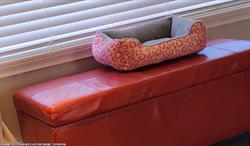Image courtesy of Barbara Deg, RVT, CDBC, CPDT-KA, CSAT
All pets will need grooming and veterinary care at some point in their lives. Setting up a predictable treatment station for your pet will help decrease stress. Choose an area that has good lighting, space to work around, and where your pet is comfortable. The goal is to create a positive association with the station so that it can be relocated if needed.
Before you begin:
- Choose a space where there are no potential triggers and cues in the surrounding environment that may impact your pet’s feelings about the situation. Consider scents, sounds, visuals, and even tactile cues in the environment.
- Provide non-slip footing for your pet around the station.
- Use pheromones and mask sounds to make the environment a more inviting place.
- Choose a space where you can easily access everything you need.
- Make sure your pet associates this area with something good. Toys, food puzzles, and food will help reinforce this feeling.
Image courtesy of Barbara Deg, RVT, CDBC, CPDT-KA, CSAT
Treatment Stations for Dogs
- A treatment station can be as simple as a mat to give a visual and tactile cue of where you want your dog to be. Non-slip bathmats or yoga mats fold up nicely and are portable.
- You may want to use an elevated station depending on your dog’s size and expected treatments. Ensure that the surface is non-slip and your dog can easily get on it. If your dog cannot jump on or off elevated surfaces, training them to accept being lifted or to climb up and down should be a separate exercise.
- Platforms can be covered with a mat to provide comfort for your dog.
- A chair or stool can be used for chin rests with your dog standing on a mat.
- Keep the treatment station area inviting for your dog by doing fun things in and around the area. Do not use the station for care that your dog may already have a bad association with before training them to love their treatment station.
Image courtesy of Barbara Deg, RVT, CDBC, CPDT-KA, CSAT
For The Cats
- Cats thrive on predictability, which makes them great when working with treatment stations.
- If the treatment station is on the ground, make sure your equipment is accessible.
- An elevated surface, such as a chair or table with a mat, works well as a treatment station.
- When using an elevated surface, make sure that there is a way for your cat to easily get on and off. Do not pick your cat up and force them onto the station.
- You can try using a high-sided bed, carrier, or box and adapt it to be a treatment station.
- Be aware of scent, visual, auditory, and tactile cues, and triggers in the environment.





